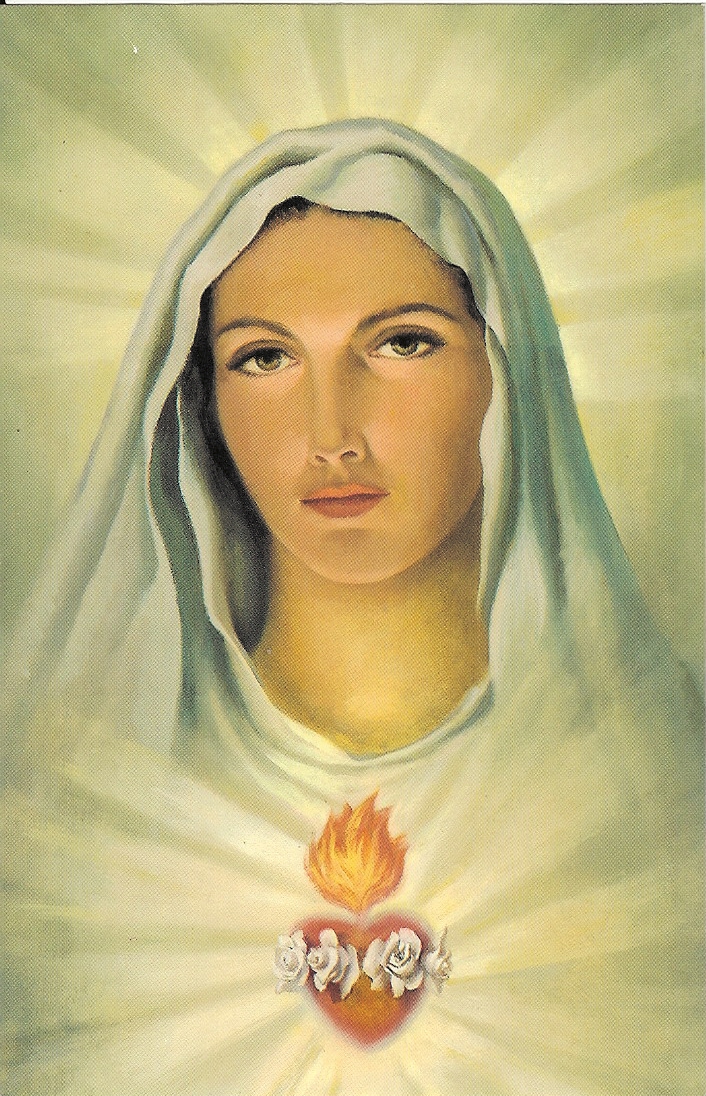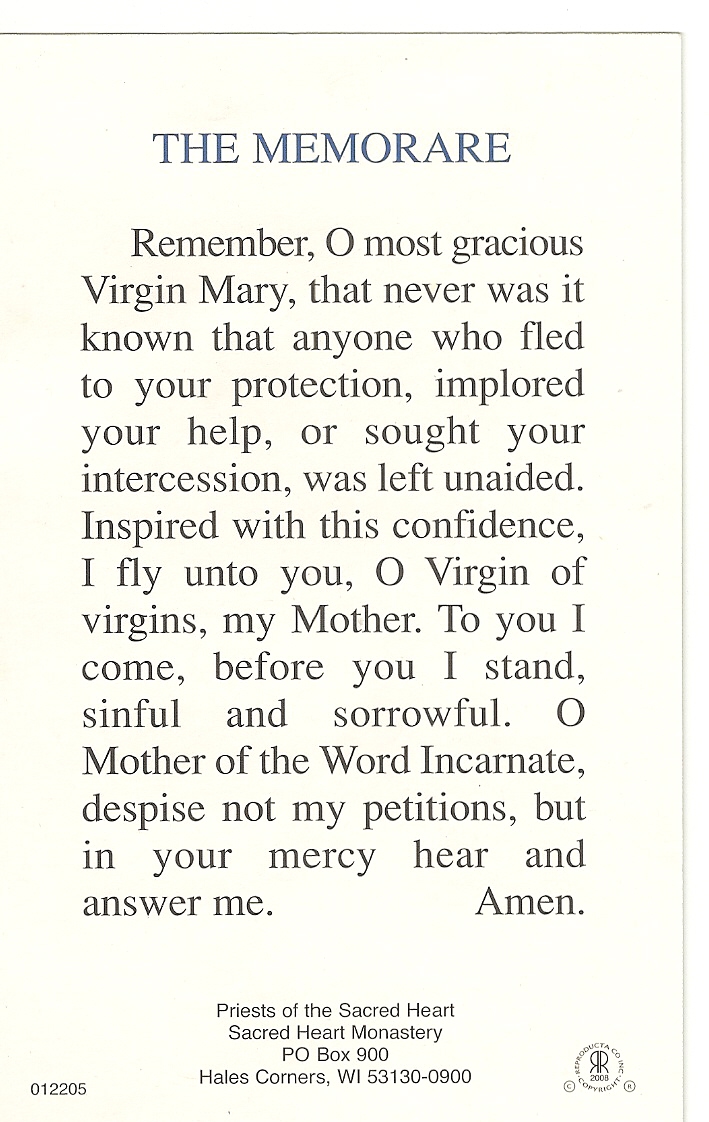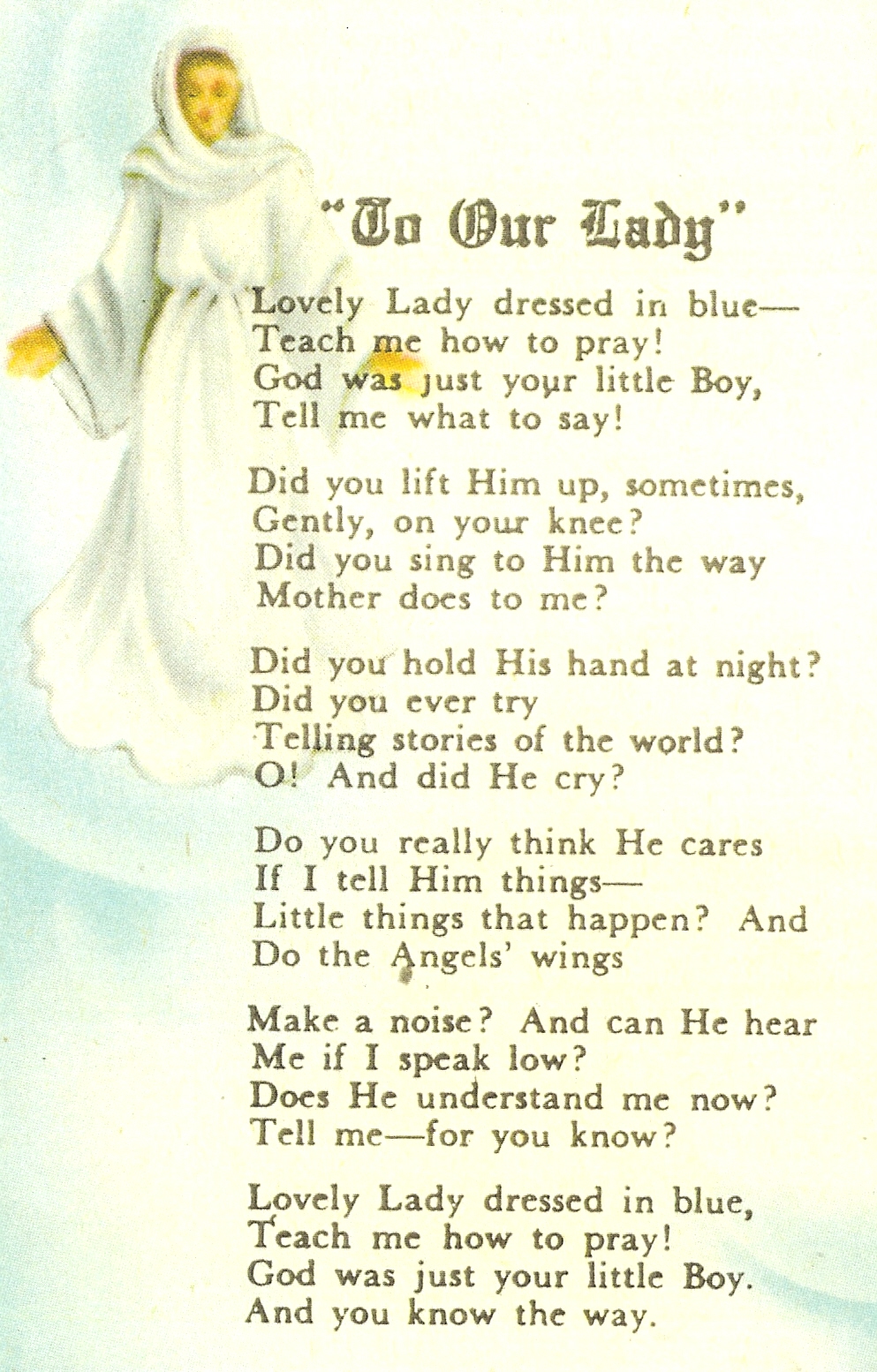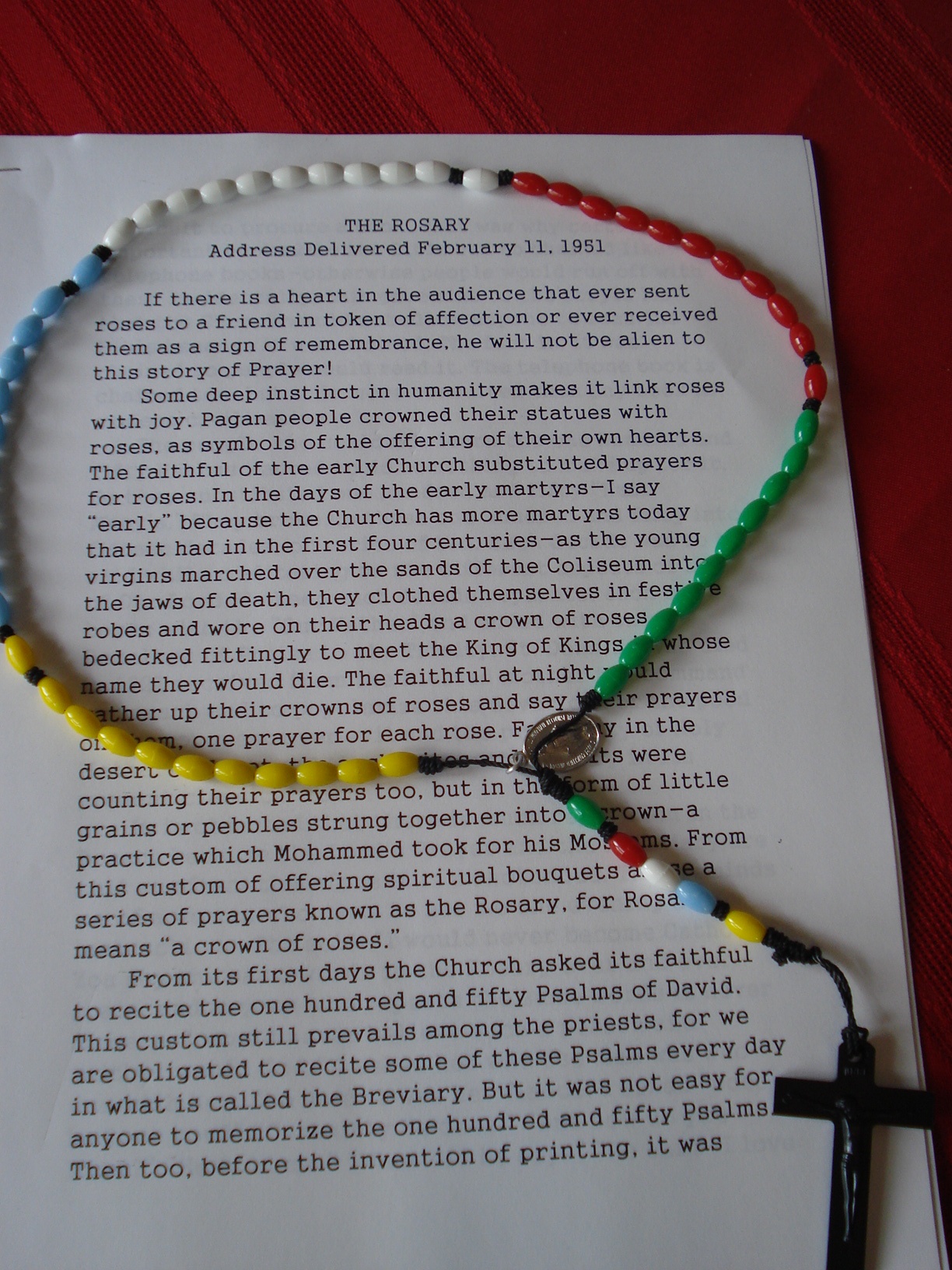
|
|
|
|
|
|
|
|
|
|
|
|
|
|
|
|
|
|
|
|
|
|
|
|
|
|
|
|
|
|
|
|
|
|
|
|
|
|
|
|
 |
 |

Hail Mary full of Grace, the Lord is with thee. Blessed are thou among women and blessed is the fruit of thy womb Jesus. Holy Mary Mother of God, pray for us sinners now and at the hour of our death. Amen.
A Tribute to Mary, Mother of Jesus

Rosary designed by Archbishop Fulton Sheen
Carolyn and Wayne Bohy of Nebraska are pictured in the Archbishop Sheen Communication Room during a visit. Carolyn's spiritual mission and "treasure" for others are her handmade World Mission Rosaries designed by Bishop Fulton Sheen.
Her heartfelt desire is to provide them to others, so they may begin praying daily, in addition to a silent Holy Hour. One of 16 children, she chose for her keepsake from her parents, their rosary. Bishop Sheen had given it to them on their 47th anniversary. The rosaries are blessed with Lourdes holy water. These rosaries are available for a love donation as are manufactured rosaries.
Please read and be inspired by the address of Bishop Sheen delivered Feb. 11, 1951 as to why he designed this prayer tool. Gratitude for this article goes to Carolyn and the Propagation of Faith in Washington, D.C.

Carolyn and Wayne Bohy with crowns of roses as Rosaries
Please contact the Centre to purchase a Rosary
The Rosary
An address delivered by FJS on February 11, 1951
If here is a heart in the audience that ever sent roses to a friend in
token of affection, or ever received them as a sign of remembrance, he
will not be alien to this story of prayer!
Some deep instinct in humanity makes it link roses with joy. Pagan peoples
crowned their statues with roses, as symbols of the offering of their own
hearts. The faithful of the early Church substituted prayers for roses. In
the days of the early martyrs---I say “early” because the Church has more
martyrs today than it had in the first four centuries—as the young virgins
marched over the sands of the Coliseum into the jaws of death, they
clothes themselves in festive robes and wore on their heads a crown of
roses, bedecked fittingly to meet the King of Kings in Whose Name they
would die. The faithful at night would gather up their crowns of roses and
say their prayers on them, one prayer for each rose.
Far away in the desert of Egypt, the anchorites and hermits were counting
their prayers too, but in the form of little grains or pebbles strung
together into a crown---a practice which Mohammed took for his Moslems.
From this custom of offering spiritual bouquets arose a series of prayers
known as the Rosary, for Rosary means “a crown of roses.”
From its first days the Church asked its faithful t recite the one hundred
and fifty Psalms of David. This custom still prevails among the priests,
for we are obligated to recite some of these Psalms every day in what is
called the Breviary. But it was not easy for anyone to memorize the 150
Psalms. Then, too, before the invention of printing, it was difficult to
procure a book. That was why certain important books like the Bible had to
be chained like telephone books, otherwise people would run off with them.
Incidentally, this gave rise to the stupid lie that the Church would not
allow anyone to read the Bible because to was chained.
The fact is, it was chained so people could read it. The telephone book is
chained, too, but it is more consulted than any book in modern
civilization.
The people who could not learn the 150 Psalms wanted to do something to
make up for it. So they substituted 150 Hail Marys. They broke up these
150 decades, or series of ten. Each decade was to be said while meditating
on the different aspects of the Life of Our Lord.
To keep each decade separate, each one began with the “Our Father” and
ended with the Doxology of Praise to the Trinity. (Glory Be.)
St. Dominic who died in 1221 received from the Blessed Mother the command
to preach and to popularize this devotion for the good of souls, conquest
over evil and the prosperity of Holy Mother Church, and thus gave us the
Rosary in its present form.
It is objected that there is much repetition in the Rosary because the
Lord’s Prayer and the Hail Mary are said so often; therefore it is
monotonous.
That reminds me of a woman who came to see me one evening after
instructions. She said: “I would never become Catholic. You say the same
words in the Rosary, over and over again, and anyone who repeats the same
words is never sincere. I would never believe such a person and neither
would God.” I asked her who the man was who was with her. She said it was
her fiance. I asked, “Does he love you?” “He told me.” “What did he say?”
He said, “I love you.” “But never before?” “He tells me every night.” I
said, “Do not believe him.” He is repeating; he is not sincere.” The
beautiful truth, there is no repetition in “I love you.” Because there is
a new moment of time, another point in space, the words do not mean the
same as before. Love is never monotonous in the uniformity in the
uniformity of its expression. The mind is infinitely variable in its
language, but the heart is not. The heart of man in the face of the woman
he loves is too poor to translate the infinity of his affection into
different words. So the heart takes but one expression, “I love you” and
in saying it over and over again, it never repeats. It is the only real
news in the universe.
That is what we do when we say the Rosary. We are saying to the Holy
Trinity, to the Incarnate Savior to the Blessed Mother, “I love you,” I
love you, “I love you.”
The beauty of the Rosary is that it is not only a vocal prayer. It is also
a mental prayer. You have sometimes heard a dramatic presentation in which
while the human voice was speaking, there was a background of beautiful
music, giving force and dignity to the words. The Rosary is like that.
While the prayer is being said, the heart is not hearing music But
meditating on the Life of Christ, but applied to our own life and our own
needs. As the wire holds the beads together, so meditation holds the
prayers together. We often speak to people while our minds are thinking
something else. But in the Rosary we do not only say prayers; We think
Bethlehem, Galilee, Nazareth, Jerusalem, Golgotha, Calvary, Mount Olivet,
Heaven---all these move before our mind’s eye as our lips pray.
Peace will come only when the hearts of the world have changed. To do this
we must pray, and not for ourselves, but for the world. The world means
everyone. Our enemies and our next door neighbors.
To this end, I have designed a Rosary called the World Mission Rosary.
Each of the five decades is of a different color to represent each of the
five continents or the world from the viewpoint of the Missions. One
decade is green for Africa, because of its green forests and because it is
the sacred color of the Moslems for whom we pray.
The second decade is red for the continent of American which was founded
by the Red Man. The third decade is white for the Continent of Europe, for
its spiritual father is the White Shepherd of the Church.
The fourth decade is blue for the Continent of Australia, Oceania and the
other islands in the blue waters of the Pacific.
The fifth is yellow for the continent of Asia, the land where the sun
rises and the cradle of civilization.
When the Rosary is completed, one has circumnavigated the globe and
embraced all continents, all people in prayer. Our Rosary has this triple
advantage. Each color reminds you of the part of the world for whom you
offer the decade. Secondly,, it fulfills Our Lady’s petition at Fatima to
pray for world peace through the Rosary. Thirdly, it will aid the Holy
Father and his Society for the Propagation of the Faith by supplying him
with practical support, as well as prayers, for the poor distressed 600
mission territories of the world each of which is larger than New England.
It all comes down to this: the world will change when we change. But we
cannot change without prayer, and the power of the Rosary as a prayer is
beyond description.
Learn to sanctify all the idle moments of life. It can be done thanks to
the Rosary. As you walk the streets, pray the Rosary in your hand or in
your pocket. While sitting in traffic, while in a waiting room, or sitting
on a train. All these moments can be sanctified and made to serve your
inner peace. If you wish to convert anyone to the fullness of the
knowledge of our Lord and His Mystical Body, teach him the Rosary. One of
two things will happen. Either he will stop saying the Rosary, or he will
get the gift of faith.
For the love of Our Lord and His Blessed Mother won’t you please make a
tour of the World on your World Mission Rosary. I know you will. Being
such good friends of mine, I really ought to send you roses.
"The Woman He Loved": Fulton Sheen and the Blessed Mother
Contributed by Fr. Andrew Apostoli, C.F.R.
Devotion to the Blessed Virgin Mary was an ever-present grace in the life of Archbishop Fulton J. Sheen. Like the sun that sends its rays of light upon the earth from its rising to its setting, so the love of Our Lady shone like a bright light over the life of the future Archbishop, from its very beginning right through to its conclusion. It left an indelible impression on his life. This devotion began with his Baptism, at the very time his life in Christ began. He describes what happened in his autobiography: When I was baptized as an infant, my mother laid me on the altar of the Blessed Mother in St. Mary's Church, El Paso, Illinois, and consecrated me to her. As an infant may be very unconscious of a birthmark, so I was unconscious of the dedication but the mark was always there. Like a piece of iron to the magnet, I was drawn to her before I knew her, but never drawn to her without Christ. (Treasure in Clay, p. 316) We can judge how much this consecration to Our Lady meant to young Fulton from the fact that he spontaneously renewed it at the age of twelve when he received his First Holy Communion. His First Communion book contained a copy of the Litany of the Blessed Virgin, which he began to recite every night as a boy and kept the practice up to his death. Later on, when he was ordained a priest, he made a resolution to offer the Holy Sacrifice of the Mass every Saturday when the Liturgy permitted in honor of Our Lady. He saw it as a way to renew his love for her and to seek her powerful intercession. As he looked toward the end of his earthly life, he felt that his love and devotion to Our Lady would be an important part of his encounter with Christ at his final judgment. He felt Our Lord would say to him: "I know all about you; my Mother told me all about you!" Archbishop Sheen's filial love and trust in Our Lady is expressed very clearly in the motto he chose for his coat of arms as a bishop: "Da per Matrem me venire," "Grant that I may come to You through your Mother."This devotion expressed itself in his visits to some of the greatest shrines of Our Lady, especially Lourdes and Fatima. He visited Lourdes over thirty times.
He experienced many special signs of Our Lady's love and care for him there. On one such occasion, when he was without money, he stayed some ten days in a rather nice hotel. He asked Our Lady to send him someone to pay his hotel bill. On the tenth and final day, a man came up to him and asked if he would accompany him and his family on a tour of Paris. When the then Fr. Sheen agreed, the man added another question, "Have you paid your hotel bill yet?"The Archbishop made about ten visits to Our Lady's shrine in Fatima. Unlike Lourdes, where the place of the apparitions of Our Lady was the focus, at Fatima the message of Our Lady was stressed. She had come with a message of hope for world peace, as well as a plan from Heaven on how to obtain it. He saw four things in Fatima. First, he came to realize on the authority of Our Lady that Communism was an evil that was trying to conquer the world as it sought to destroy the Catholic Church. This conviction led him to be an unrelenting opponent of Communism in the West. His voice was often the only one to be heard opposing Communism because so many in the West did not see its dangers. He would often say, "We do not need a voice that's right when everybody else is right, but we need a voice that's right when everybody else is wrong."Fatima impelled him to be that voice! Secondly, the Archbishop saw in Our Lady of Fatima a hope of converting the Muslim people. He held that Our Lady did not appear in the only place in Portugal with a Muslim name (Fatima was named after a Muslim princess who converted to the Catholic faith), simply to convert Russia.
She came also for the conversion of the Moslem people because, as he believed, unless a great number of Muslims were converted, there would never be peace in the world. He said: I believe that the Blessed Virgin chose to be known as "Our Lady of Fatima" as a pledge and a sign of hope to the Muslim people, and as an assurance that they, who show her so much respect, will one day accept her Divine Son too!" Thirdly, Archbishop Sheen saw in Fatima a call to greater conversion of one's own life as well as a call to make reparation and intercession for the conversion of sinners. These themes conversion, reparation, intercession were central to the Archbishop's writings on the spiritual life. He called for constant conversion from the world to Christ. His famous comparisons of the Western world with the Communist world show this. For him, the West had Christ, but without the Cross no discipline, no self-denial, no mortification. He called this Western conception "a soft, effeminate Christ Who cannot save us!"
In contrast, the Communist world had the Cross but without Christ's oppression, persecution, suffering. The Archbishop posed the question: "Will the West find the Cross before the East finds Christ?" Reparation and intercession were likewise important for every Christian because they are part of our baptismal co-redemptive mission with Christ so that, like St. Paul, we will fill up with the sufferings in our own bodies what is lacking in the sufferings of Christ for the sake of His Body, the Church (cf. Col. 1:24). He especially stressed reparation and intercession by priests. In his wonderful writings and talks on the priesthood, Archbishop Sheen would remind them constantly that they were called to be both "priests" and "victims" with Christ. This was part of their essential mission of saving souls. Fourth, Archbishop Sheen drew from the Fatima message the importance of the Rosary. Our Lady asked in each of her appearances: "Pray the Rosary every day!" She pointed out its power: "The Rosary can end wars! The Rosary can bring peace! The Rosary can convert sinners!" Archbishop Sheen loved the Rosary and prayed it daily from his childhood when his family would pray it together in the evenings. As National Director for the Society of the Propagation of the Faith, he would gather around all the workers (and any visitors who happened to be there) in his New York office at 3:00 p.m., and recite the Rosary.
Most significant of all was his design of the World Mission Rosary. The Archbishop introduced this unique Rosary during his radio broadcast on "The Catholic Hour" on February 11, 1951, the Feast of Our Lady of Lourdes. Each of the five decades is of a different color to represent each of the five continents of the world from the viewpoint of the Missions. He said: "Our Rosary has this triple advantage. Each color reminds you of the part of the world for whom you offer the decade. Secondly, it fulfills Our Lady's petition at Fatima to pray for world peace through the Rosary. Thirdly, it will aid the Holy Father and (the work of) his Society for the Propagation of the Faith..." He concluded his broadcast: Thus in five decades, one covers two worlds: the spiritual world of either the Joyful, Sorrowful or Glorious Mysteries of Our Lord and the physical world of the five continents. May the Blessed Mother, who stood beneath the Cross on whose banner was written the three languages of the then known great civilizations of the world, now extend her help and mediation to the enlarged worlds of the five continents.
The Archbishop was to sum up his reflections on our Blessed Mother in one of his greatest books, "The World's First Love." He divides the book into two parts. Part I is entitled: "The Woman the World Loves." Here he examines the life of Our Lady from her Immaculate Conception to her Assumption into Heaven. Part II is entitled: "The World the Woman Loves." Here the Archbishop shows how we need the Mother of God to help us deal with the problems and confused beliefs that confront mankind today. This book is truly a treasury of love, reverence and devotion to Our Blessed Mother. These words of Archbishop Fulton J. Sheen serve as a last pearl of great price from his pen: On dark nights we are grateful for the moon: when we see it shining we know there must be a sun. So, in this dark night of the world, when men turned their backs on Him Who is the Light of the World, we look to Mary to guide our feet while we await the sunrise.
Fr. Andrew Apostoli is a member of the Franciscan Friars of the Renewal, a frequent guest on the EWTN television network, and the postulator for the cause of the Servant of God, Fulton J. Sheen.
Life Dates | Visitors |
Museum
| Special People |
Holy Mother Mary
St. Mary's Church |
Become a Volunteer | Buy a Book |
Museum Shop
How to Find Us | Our Future |
Our Beginnings | Photo Gallery
| Links | Personal Testimonies
Calendar of Events | Bishop Sheen Quotes |
Inspirational Messages |
Contact
Us | Home
